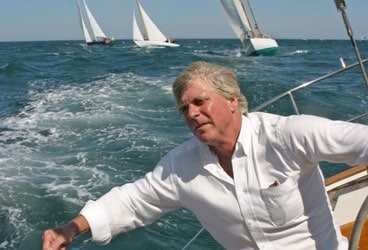
Thorpe 368
Thorpe Leeson could hardly believe his good fortune. Leeson is one of those sailors who lives and breathes the sport: His “day job,” skippering a Swan 61, forces him to maintain the highly enviable schedule of winters in the Caribbean and summers in New England. But Leeson’s true love is classic wooden boats, and he’s owned a small armada of them. Last winter, surfing the web, he came across a 41-foot Danish-built sloop for sale on San Francisco Bay, and he needed to know more. The price, frankly, seemed ridiculously low. He reckoned there had to be something wrong with the boat. He hired a surveyor to take a look, and then gave him a call.
“What’s the matter with her?” he asked.
“Nothing,” said the surveyor. “The owner just wants out. If you don’t buy the boat, I will.”
So, for the grand sum of $19,000–plus another five grand to have the boat trucked across country–Leeson was the proud new owner of a staunch cruising boat called Alegria, originally built of mahogany for the Fastnet race in 1967, then later sailed to California, where she’d spent many happy years. Leeson was indeed a lucky man to have scored such a prize.
He told me the tale last month, on the sparkling isle of Nantucket, off the coast of Massachusetts, just moments before we hoisted the sails to participate in the 36th annual Opera House Cup. I’d come out to the island to do a story on the resurgence of classic yachts and racing for Cruising World’s sister publication, Sailing World, a revival supported in no small way by the Italian watchmaker Panerai, which sponsors the Opera House regatta as well as a number of events in the Mediterranean and the Caribbean. I was looking for a ride and fortuitously ran into Leeson, an old mate from Newport, who had an open slot aboard Alegria. I’d heard he had a new boat and, with her varnished coach roof and clean lines, she was every bit as fetching as advertised.
Leeson’s an old hand on Nantucket and is a veteran of nearly every Opera House Cup since its inception back in 1972. “It was just a bunch of old wooden boat freaks that got tired of sailing around in a sea of plastic,” he said. “I think it started out with something like four boats. Now it’s pretty much the premier wooden boat regatta in the United States.”
He wasn’t kidding. The assembled fleet was, in some ways, a microcosm of the history of yachting. The figurative queen of the gathering was the 135-foot gaff schooner Eleonora, an exact replica (built in 2000) of Nat Herreshoff’s Westward, originally launched in 1910. L. Francis Herreshoff was also well represented by his 72-foot ketch Ticonderoga, among other designs.
Then there was When and If (one of my favorite boat names of all time), the John Alden-designed schooner commissioned by General George S. Patton in 1939 (Patton named the boat by stating that “when and if” he returned from the upcoming World War II, he’d sail around the planet; alas, he was killed in a car crash in Europe shortly after order was restored).
And let’s not forget the 52-foot yawl Dorade, designed by Sparkman & Stephens, the famous winner of the 1931 Transatlantic Race and the subsequent Fastnet race, too, ably skippered in both by her young creator, Olin Stephens.
All that was put aside, however, when it got down to the rather exacting business of getting Alegria around the racetrack. A front had rolled through the night before, and in its aftermath were gloriously clear skies and puffy, west-southwest winds clicking in at a steady 15 knots with gusts of around 20. “We’re going to want to put a reef in,” said Leeson, while his crew–the father and son duo of Jim and Zack Wallen, and energetic sailors Renee Bissell and Kym Scott–leaped into action.
Among the chief protagonists in our class were a pair of Concordia yawls, Harbinger and Skye, and we got off the starting line more or less in company with the two beautifully maintained 40-footers. There was a short windward leg before we turned downwind and shook out our reef for a longish run to the next mark, the second of many on the 30-mile zigzagging course the race committee had issued.
“This race has more legs than the Rockettes,” joked the elder Wallen, who was handling the navigation.
The third of those legs was a broad reach before we came back on the wind and once again tied another reef into Alegria’s mainsail. By now we were laboring somewhat in a very confused wind-against-current seaway, and Lesson looked visibly pained when we crashed through yet another square wave. He handed over the helm and went down below to have a peek at the bilge, and when he popped back on deck, he had some rather depressing news.
“We’ve got a little leak,” he said. “Nothing serious. But that’s it. We’re retiring.”
As it turned out, we had more than a little company: a full quarter of the 60-boat fleet pulled the plug early and sailed back into the harbor to prepare for the evening’s award ceremony (the overall winner of the Opera House Cup was a 29-foot Dragon called Elska) and related festivities. Hey, just because the proverbial Fat Lady sang early, there was no reason to forgo a bracing rum or two.
By the time we were back on the mooring (and the bilges were again tight and dry), Leeson was philosophical about how the day had transpired. “Well, I would’ve liked to have finished what we started,” he said. “But the more important thing is, I want to own this boat for a long time.”
It was impossible to question his logic, even if the opera had been cut short.







